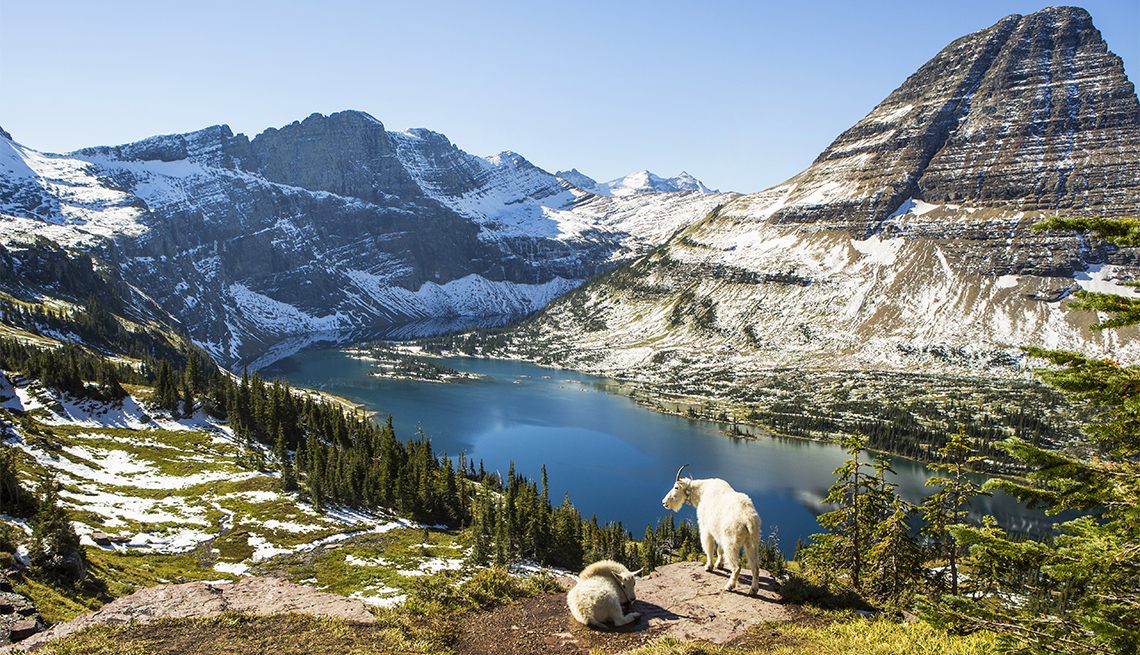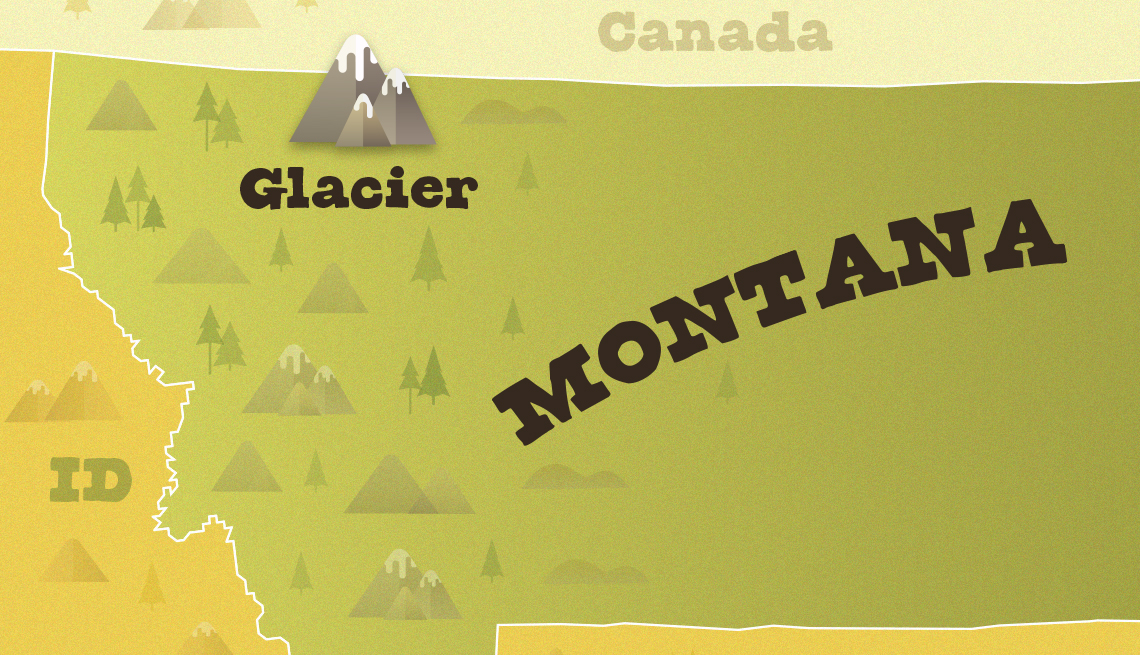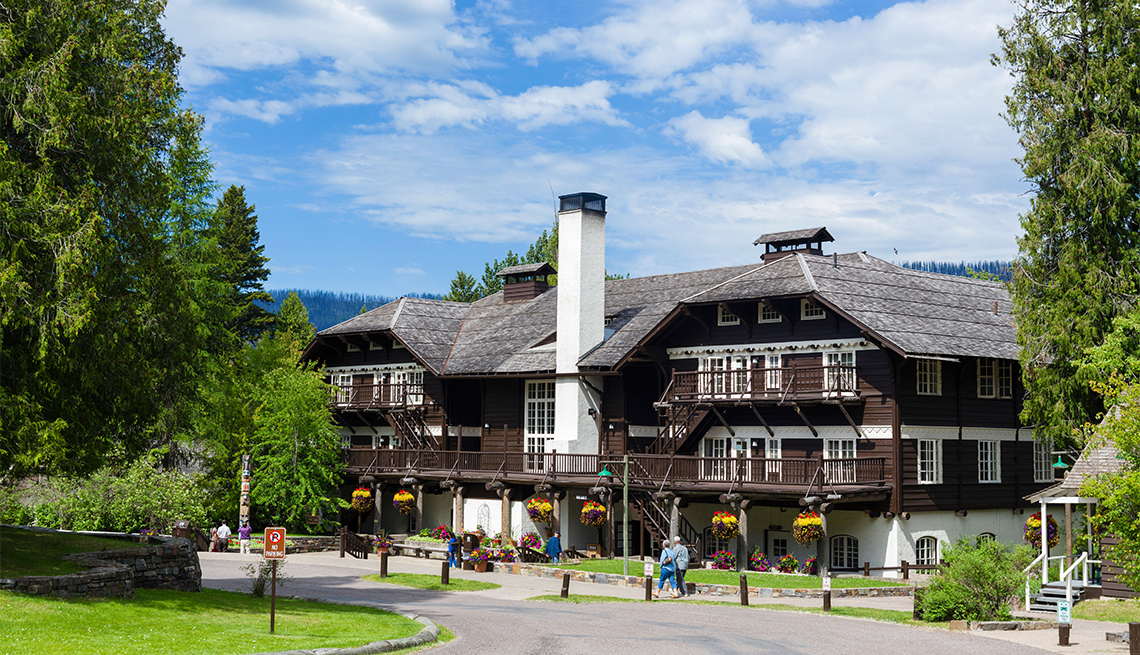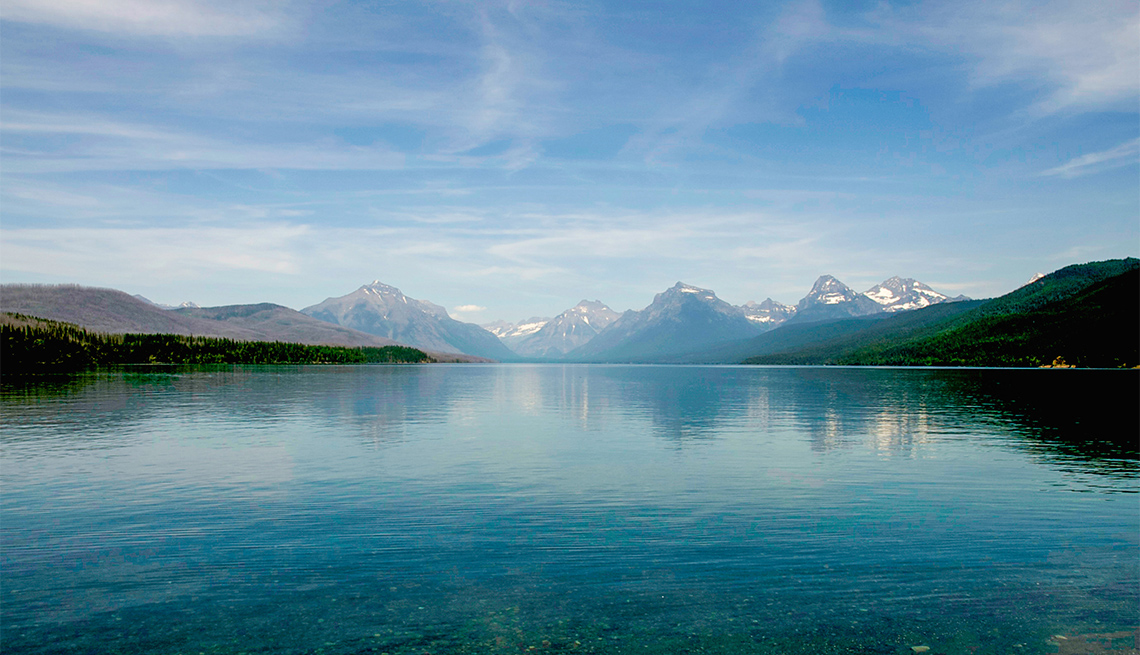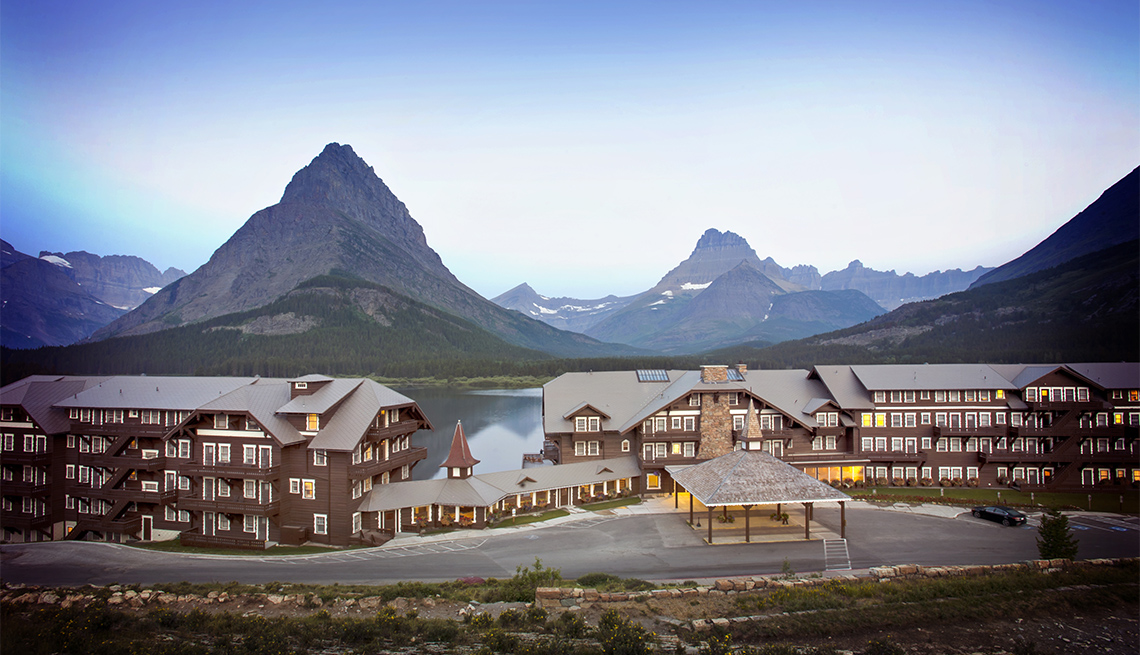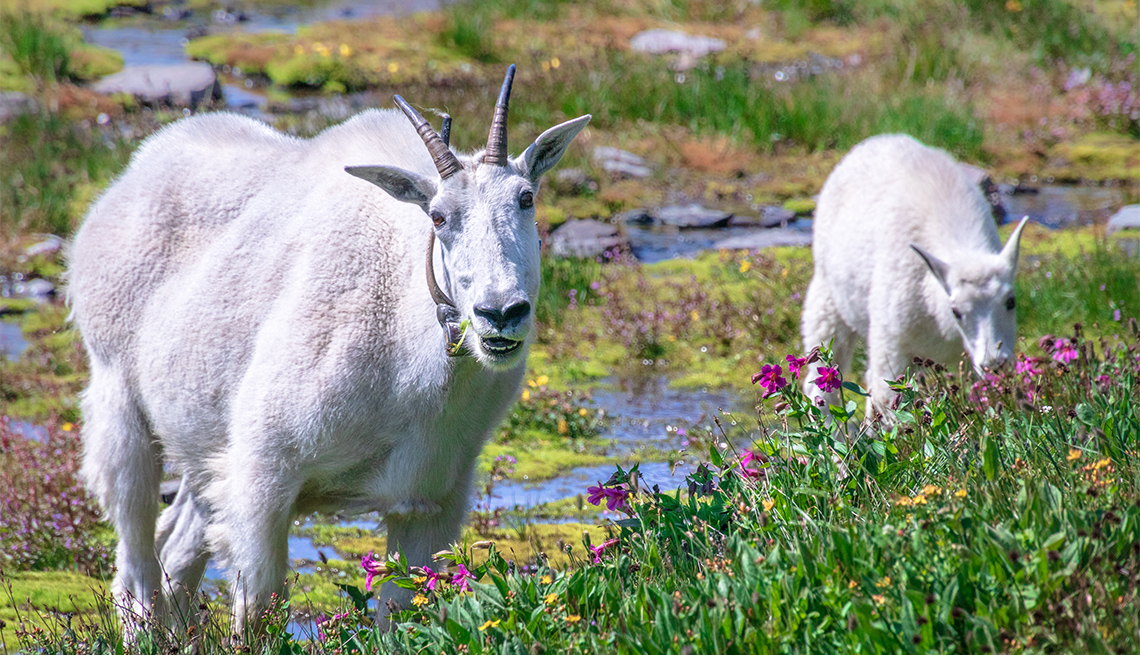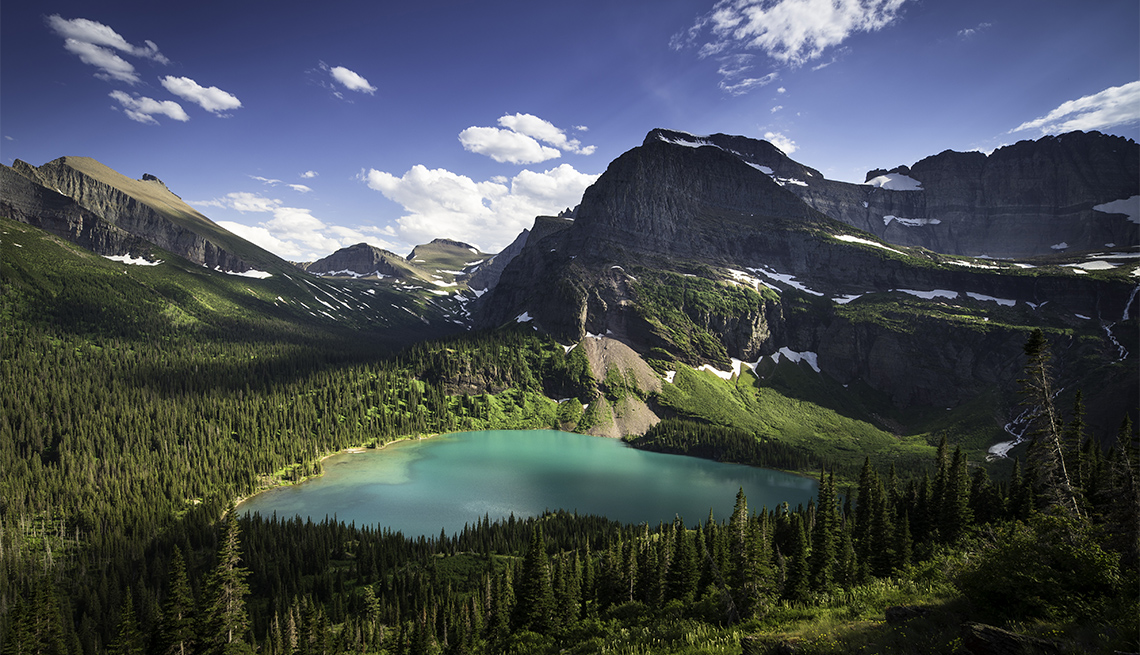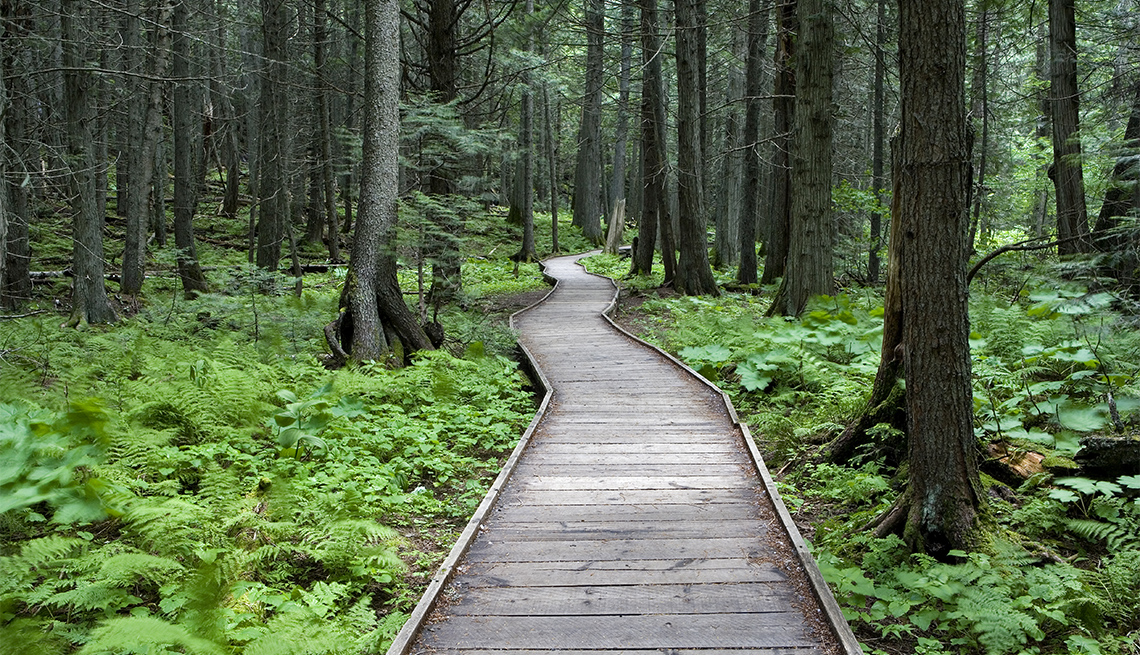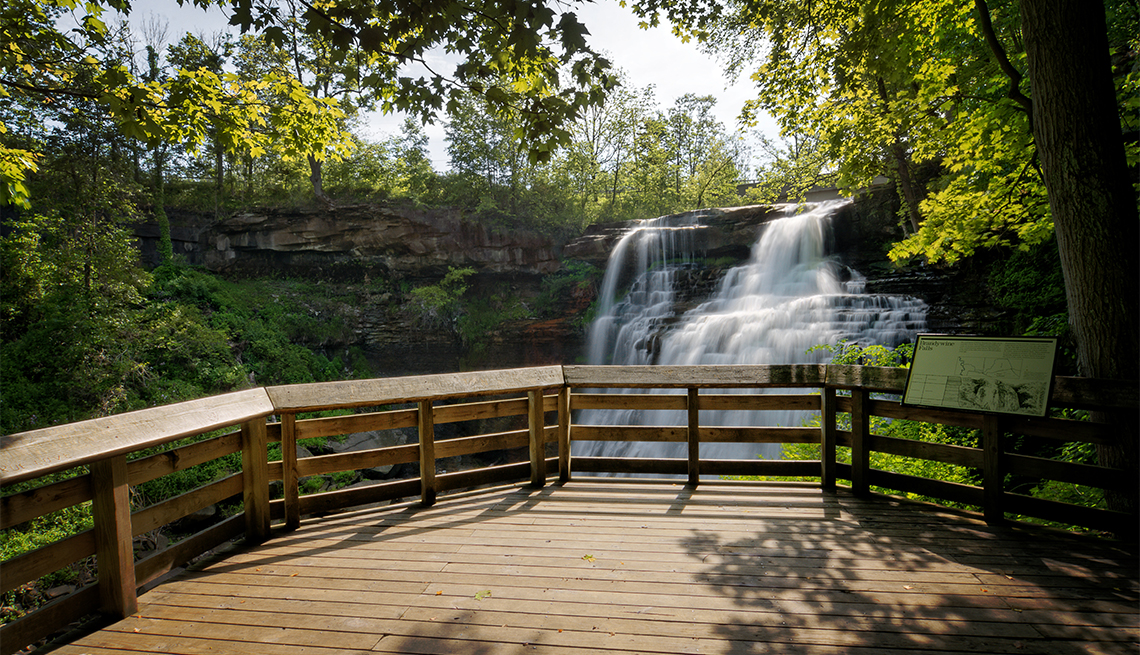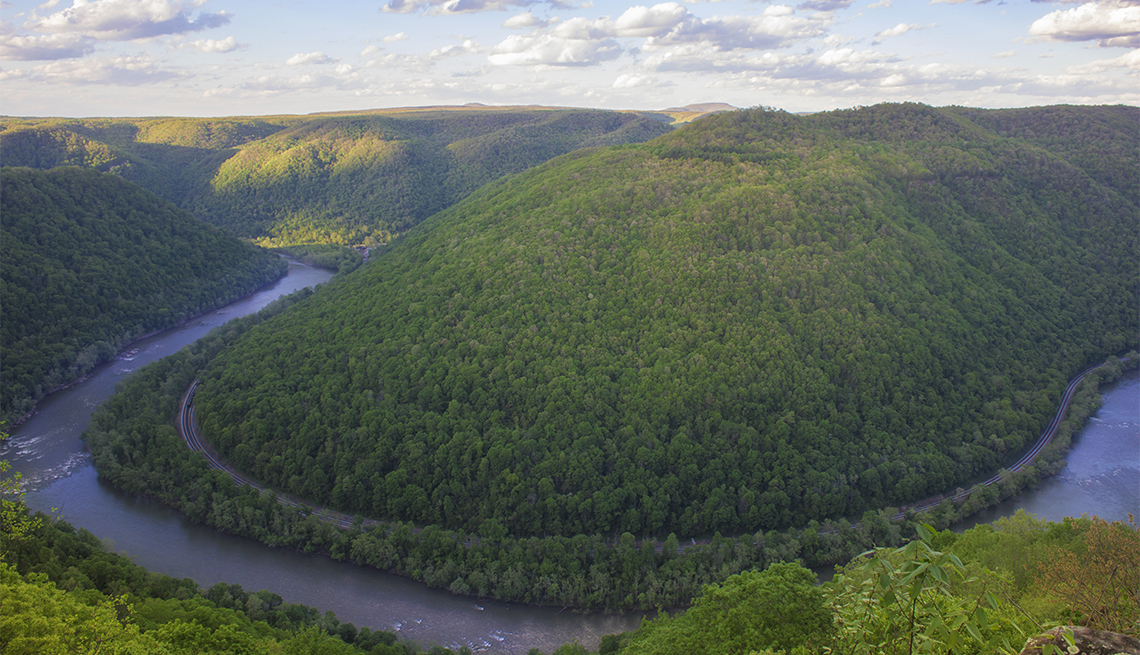AARP's Guide to Glacier National Park
Find wildlife, turquoise lakes and snowcapped peaks in Montana
En español | The land we now call Glacier National Park (GNP), in northwest Montana, has been known by many names through the centuries. To members of the Blackfeet Nation, whose ancestors thrived here for thousands of years, it was the “Backbone of the World,” for its serrated peaks. To explorer and naturalist George Bird Grinnell, who negotiated the purchase of eastern Glacier from the Blackfeet and lobbied Congress to establish it as a forest preserve and later a national park in 1910, it was the “Crown of the Continent,” for its glaciated mountains. Great Northern Railway, which owned the tracks around the park's southern flanks, erected a series of lodges and chalets for its passengers and promoted the area as “America's Switzerland.”
Glaciers carved these mountains, leaving jagged ridges called arêtes, three-sided horn peaks, scooped-out cirque basins and deep U-shaped valleys — a vertical landscape that plunges from 10,448-foot Mount Cleveland to 3,153 feet at the clear waters of Lake McDonald, the park's largest lake. The Continental Divide, which runs north-south through Glacier, sends water to the Pacific and Atlantic oceans, splitting this park of 1,012,837 acres into a west side of long lakes surrounded by coniferous forests and an east side of aspen groves mixed with wildflower meadows.
A place of stunning beauty, the park attracts about 3 million visitors annually, eager to spot wildlife — it's home to grizzly bears, black bears, elk, bighorn sheep and many more species — and motor along its famed Going-to-the-Sun Road.
Location: Northwest Montana, on the U.S. border with Canada
Acreage: 1,012,837
Highest peak: Mount Cleveland, 10,448 feet
Lowest valley: Lake McDonald, 3,153 feet
Miles of trails: 734
Main attraction: Going-to-the-Sun Road
Cost: $35 per vehicle, good for seven consecutive days (Annual Senior Pass is $20)
Best way to see it: With Red Bus Tours on its red buses, a longstanding park tradition, or with Glacier Sun Tours, for a Native American perspective
When to go to avoid the crowds: Outside the July-Labor Day window
Plan Your Trip
The closest airport to GNP is in Glacier Park, Montana, 24 miles southwest of the park in the Flathead Valley. Great Falls, Montana (143 miles southeast), and Spokane, Washington (272 miles southwest), also have airports, but the Canadian city of Calgary (225 miles north) offers the most air service. For an alternative to flying from Chicago, Milwaukee, St. Paul-Minneapolis, Seattle or Portland, Oregon, Amtrak's Empire Builder route runs on the original Great Northern Railway route around Glacier's southern boundary, with rangers aboard to provide interpretation. The train stops in West Glacier year-round and East Glacier in summer.
Fill up your tank before entering the park, which has no gas stations. Also, check current road conditions and the Recreational Access Display for the real-time status on campgrounds, weather, road restrictions and parking lot congestion.
Sixty percent of GNP's visitors enter the year-round park through the west entrance at West Glacier, paying $35 for a seven-day visit ($20 with an Annual Senior Pass). Nearby, at the small Apgar Visitor Center, get oriented before heading into the park on the 50-mile Going-to-the-Sun Road — the lone road leading to its interior, and open only in summer (usually starting in late June, when the snow melts). Driving it isn't easy, especially in heavy summer traffic. The narrow, two-lane road climbs a 6 percent grade up to the Continental Divide, cutting through cliffs and hugging vertical walls. The road has size restrictions for RVs and trailers due to tight curves and overhangs, but you can always opt for a guided bus tour or a free shuttle as an alternative to driving.
Wildflowers peak from mid-July through early August, which is when the park sees its driest and warmest weather, usually ranging from 50 to 80 degrees. June and September waffle between pleasant sunny days and cooler, stormy weather, sometimes including snow. The weather can be fickle by elevation, too: You might find blazing sun at Lake McDonald and strong, cold winds battering Logan Pass (bring layers of clothing).
In spring and fall, the weather yo-yos then between bouts of wintry and warmer days, with daytime temperatures ranging from 40 to 70 degrees and nighttime sometimes dropping below freezing. In spring and after mid-October, you can access only the lower elevations of Going-to-the-Sun Road and hiking trails. Since most visitor services and facilities are closed, Flathead Valley can serve as a base for your visit.
In winter, when snow buries Glacier and temperatures can plunge below zero when Arctic fronts arrive, cross-country skiers and snowshoers relish touring the snow-covered roads. The only plowed route for sightseeing hugs Lake McDonald on the western 10 miles of Going-to-the-Sun Road. Again, there are no services or open facilities, except for a few vault toilets.
In summer, you'll find flush-toilet restrooms at lodges and visitor centers. Picnic areas have restrooms, too — some with flush toilets, others with vault ones. Going-to-the-Sun Road has a few vault ones near some, but not all, trailheads. A handful of hiking trails have pit toilets. Most wheelchair-accessible overlooks and trails offer benches for resting. Expect to be out of cell service throughout the park except at the Apgar and St. Mary visitor centers, which also have limited free Wi-Fi. Still, download anything you'll need before leaving home.
Where to Stay and Eat
GNP's lodges are clustered in various park locations, along with restaurants and other visitor services: on the west side at Apgar, on Lake McDonald's north and south ends, on the east side at Rising Sun near St. Mary Lake, and farther north in Many Glacier. Open in summer, most have only no-frill rooms (no televisions, no air-conditioning), though the two most popular and largest lodges — Many Glacier Hotel and Lake McDonald Lodge — have a few upscale options.
The Great Northern Railway opened Many Glacier Hotel in 1915 on Swiftcurrent Lake as the “Showplace of the Rockies.” With 214 rooms, this five-story hotel fashioned after a Swiss chalet vaults upward with an immense, balcony-rimmed lobby that surrounds a four-sided (freestanding) fireplace. Outdoors, you can absorb the stunning scenery from a deck chair.
Lake McDonald Lodge graces the lake's shore. Although it was built in 1913 by landowners who acquired their property prior to Glacier becoming a park, it, too, mimics the Swiss-chalet style and features a high-ceilinged lobby with a large stone fireplace. Its 82 rooms are spread across the lodge, duplex cabins, upscale Cobb House and budget Snyder Hall, which has shared bathrooms.
For something less pricey, choose from Glacier's smaller motels and cabins. But make your reservations at least 13 months in advance. Glacier National Park Lodges operates the Apgar Village Inn, Lake McDonald Lodge, Many Glacier Hotel, Rising Sun Motor Inn and Swiftcurrent Motor Inn. Pursuit Glacier Park Collection runs the Apgar Village Lodge and Motel Lake McDonald.
For a true getaway, you can book lodging in one of two rustic chalets built by the Great Northern Railway in ultra-scenic backcountry locations. The hitch? You must hike 7.6 miles to the 12-room Granite Park Chalet (open June 28 through Sept. 12) or 6.7 miles to the 17-room Sperry Chalet (open July 11 through Sept. 12). Both are National Historic Landmarks that book up quickly every year, starting in January.
There are 13 summer campgrounds ($10 to $23 per night) set in forested settings near lakes, rivers and hiking trails. They all have picnic tables and fire rings, but no hookups. Paved roads lead to eight that have drinking water and flush toilets, dirt roads to five with vault toilets and no drinking water. Make reservations six months in advance for the campgrounds at Fish Creek, Many Glacier, St. Mary and the group campsites at Apgar. The rest are first come, first served, but arrive early, because some fill up by 8 a.m., others by late morning.
Go deeper into Glacier at 65 primitive backcountry campgrounds ($7 per person, per night from May through October; free, November through April).
The park's only restaurants are in its lodging locations, and they often have waiting lines because none take reservations. Splurge on the Montana bison tenderloin at Many Glacier Hotel's dining room, where floor-to-ceiling windows overlook Swiftcurrent Lake and the mountains. At Lake McDonald Lodge, try the charcuterie of game meats at Russell's Fireside dining room, with its peekaboo lake view. For a lighter meal, cross the parking lot to Jammer Joe's Grill and Pizzeria.
Camp stores in the lodge areas sell convenience foods, something you won't find anywhere on Going-to-the-Sun Road, not even at Logan Pass.
Things to Do
Sightsee by car. The Going-to-the-Sun Road runs 50 miles from West Glacier to St. Mary and features tunnels, a switchback, scenic pullouts, rock walls, arches and bridges while climbing to viewpoints that show off the park's glaciated scenery. “You get some epic views of the park without having to hike,” says Gina Kerzman, GNP's public affairs officer.
On the west side, short accessible trails of less than a mile go to McDonald Falls, Trail of the Cedars, Red Rock Point and Oberlin Bend.
At Logan Pass, the road's high point at 6,646 feet, bighorn sheep and mountain goats frequent the meadows. Tour the tiny summer-only Logan Pass Visitor Center (which sits on the Continental Divide), walk the paved interpretive loop and document your location with a photo next to the Continental Divide sign.
On Glacier's east side, use your binoculars at Jackson Glacier Overlook for an up-close view of the glacier. Farther along St. Mary Lake, snap photos at Wild Goose Island Overlook, with its postcard view of the turquoise lake backdropped by the rugged Continental Divide.
Two short spur roads on this east side lead to idyllic lakes. One takes you to Two Medicine Lake; the other to Many Glacier, the hub of several small valleys loaded with lakes and trails.
Although low rock and log retaining walls edge most of the road, steep cliff sections can deliver a bit of vertigo. While ascending the west side, acrophobes should sit on a car's driver side to be farthest from the edge.
Insider tip: Make the drive at sunrise or sunset. From 8 a.m. to 5 p.m., the road clogs with heavy summer traffic, and the Logan Pass parking lot packs out, forcing visitors to forgo the pass. Better yet, let someone else do the driving by taking a guided tour that stops at overlooks and has guaranteed parking at the pass. Glacier Sun Tours uses large-windowed buses on which Blackfeet guides share an Indigenous perspective on the park. Rollback tops on Red Bus Tours’ red buses, renovated historic touring buses from the 1930s, ensure unobstructed mountain views. Or take a free shuttle that stops at lodges, campgrounds, trailheads and the pass, though there's no narration and no overlook stops.
Go hiking. GNP's 734 miles of trails provide recreational activity for all ages. “The appeal is so much variety for all hiking levels here,” says Denny Gignoux, 51, who has been guiding park hikes since 1994. “You can start with something easy and then step it up as you feel comfortable.” Gignoux, an owner of Glacier Guides, says half of the company's day-hiking clients are over age 50.
Going-to-the-Sun Road offers access to two of the park's most popular short trails. At Avalanche, on the west side, the 0.7-mile Trail of the Cedars loops on a level accessible boardwalk and hard-surface path through old-growth rainforest to Avalanche Creek, gushing through a gorge. “My grandparents did Trail of the Cedars in their 80s. The trail is easy to do, with stable footing,” says Gignoux.
At Logan Pass, climb 1.4 miles to Hidden Lake Overlook. A boardwalk and dirt trail ascend through fragile wildflower meadows to the scenic viewpoint at 7,125 feet, where steep mountainsides plunge into the blue lake and mountain goats often hang out.
In Many Glacier, tackle the gentle Grinnell Lake Trail, either by walking its complete 3 miles or whittling the distance down to 1.1 miles by taking the lake tour boat that also serves as a hiker shuttle. “There are so many smaller hikes to do from boat tours, and they're always rewarding,” says Gignoux.
Partake in other recreation. In summer, rent a canoe, kayak or rowboat from Glacier Park Boat Company for paddling on Lake McDonald, Swiftcurrent Lake or Two Medicine Lake. Fish for native cutthroat trout from small rental motorboats on Lake McDonald and Two Medicine Lake. On a hot day, wade or swim in a lake, though the water may be chilly.
On land, you can explore Glacier on horseback with Swan Mountain Outfitters, whose guided trail rides range from one hour to all day. Find corrals near the west entrance, Lake McDonald Lodge and Many Glacier Hotel. In Apgar, Glacier Outfitters rents bicycles, including e-bikes, near a paved 2-mile forested bike path to West Glacier.
Learn from Native Americans. For a top evening event, local tribal members from the Blackfeet and Flathead nations present Native America Speaks programs in campground amphitheaters, park lodges and the St. Mary Visitor Center. They share stories, music or dance to convey their cultural heritage and Glacier traditions.
Escape the big crowds. Access less-visited Two Medicine, tucked in Glacier's southeast corner, via a paved road running through wildflower meadows and forest. Stop to walk the 0.3-mile accessible interpretive trail to Running Eagle Falls, named for a female Blackfeet warrior. Part of the waterfall pours 40 feet over a cliff and the other runs underground and spews out a chute. At the road's end, the glacier-carved Two Medicine Lake sits below hulking Rising Wolf Mountain. On the 45-minute narrated boat tour that circles below peaks with Blackfeet names (Sinopah, Lone Walker and Painted Tipi), you'll hear stories about them and learn about the area's geology. Some launches include a 0.9-mile guided hike to Twin Falls, two 80-foot flumes splashing down rocky ravines. Tours depart several times daily.
AARP Membership -Join AARP for just $15 for your first year when you enroll in automatic renewal
Join today and save 25% off the standard annual rate. Get instant access to discounts, programs, services, and the information you need to benefit every area of your life.
Gateway Towns
At GNP's west entrance, West Glacier borders the Middle Fork of the Flathead River, which forms the park's southwestern boundary. For eight months of the year, it's a sleepy place, with shuttered businesses and about 200 residents. But come summer, it bustles with visitors frequenting restaurants and checking into cabins, campgrounds, lodges and motels. For a bit of nostalgia, book the no-frills Belton Chalet, a rustic lodge built in 1910 by Great Northern Railway to draw visitors to Glacier. Order a frosty Moose Drool beer and the bison meatloaf at its restaurant. While in town, don't miss a river rafting trip with a local outfitter.
About 40 minutes west of GNP is the Flathead Valley's largest resort town, Whitefish, the park's year-round gateway. A must-do: a Whitefish Mountain Resort gondola ride to the summit to take in the panorama of Glacier's peaks. Pamper yourself at the upscale, 125-room Lodge at Whitefish Lake, where you can soak in the outdoor heated pool or hot tub and go Zen in the spa. At sunset, dine in its restaurant for the picturesque lake views.
Flanking the park's east side are St. Mary and East Glacier, two tiny towns on the Blackfeet Nation reservation. Home to about 50 year-round residents, St. Mary anchors the east entrance to Going-to-the-Sun Road and balloons with visitors in summer, when services open — gas stations, restaurants, shops and lodging options (including a KOA campground for tents and RVs with hookups).
Just outside the park's southeastern corner, in East Glacier, stay at Glacier Park Lodge, which Great Northern Railway opened in 1913 as GNP's headliner hotel. Its three-story lobby wows with huge Douglas Fir columns, and its back deck faces Dancing Lady Mountain. Walk across the railroad tracks for margaritas and chili rellenos at Serrano's Mexican Restaurant.
En Route
When traveling from Billings or Yellowstone National Park on Interstate 90, don't miss Missouri Headwaters State Park outside Three Forks, 31 miles west of Bozeman. Here, the Gallatin, Jefferson and Madison rivers form the source of the 2,300-mile Missouri River. Hiking trails and interpretive sites cover Lewis and Clark's Corps of Discovery and Indigenous people, including Sacajawea.
From Missoula, Montana, going north on U.S. Highway 93, view bison herds at the National Bison Range. As you drive the dirt loop through native grasslands, you may also spot bighorn sheep, deer, elk, pronghorn and raptors. Bring binoculars and a camera.
- |
- Photos

